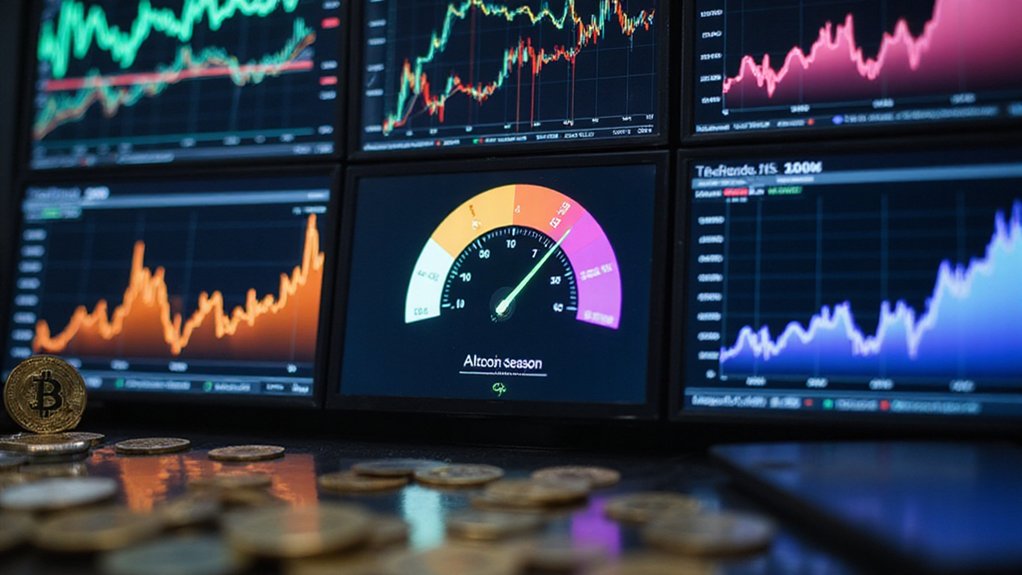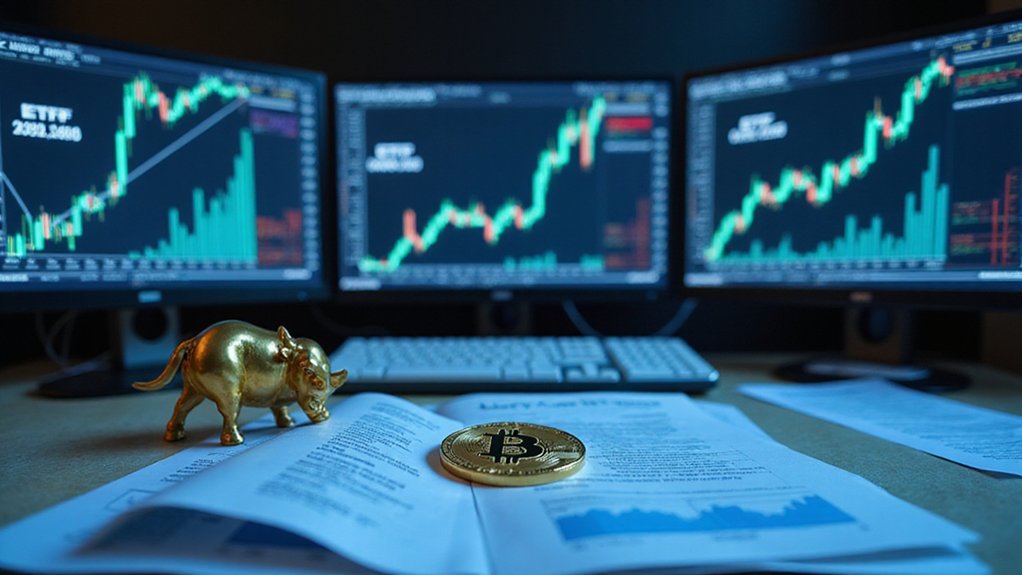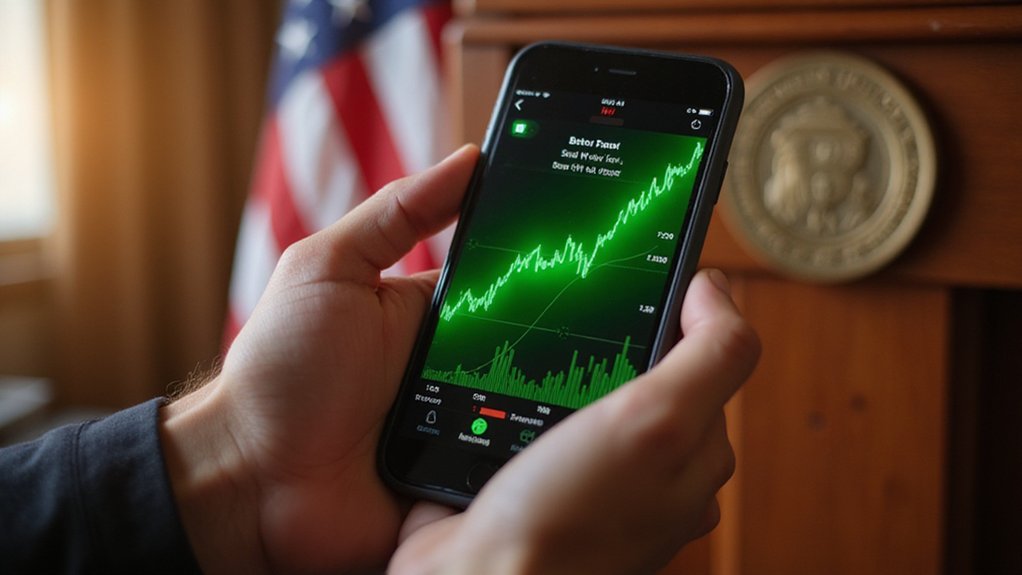The Altcoin Season Index (0-100) quantifies cryptocurrency market rotation, tracking how top 50 altcoins perform against Bitcoin over 90 days. Readings above 75 signal an “altcoin season” where alternative cryptocurrencies outshine Bitcoin, while scores below 25 indicate Bitcoin’s market dominance. This cyclical barometer—excluding stablecoins and wrapped tokens—provides traders a navigational tool for timing capital deployment between Bitcoin’s relative stability and altcoins’ speculative potential. The savvy investor recognizes these patterns before the broader market catches on.

The Altcoin Season Index stands as a critical barometer in the cryptocurrency ecosystem, offering traders a quantifiable metric to identify those elusive periods when Bitcoin’s dominance wanes and alternative cryptocurrencies surge.
This numerical compass, ranging from 0 to 100, distills complex market dynamics into a single, actionable figure that savvy investors monitor with near-religious devotion.
By tracking the performance of the top 50 altcoins against Bitcoin over a 90-day period, the index strips away market noise to reveal underlying sentiment shifts.
When the index surpasses 75, it heralds the arrival of “altcoin season”—that peculiar financial phenomenon where 75% or more of leading altcoins outperform the original cryptocurrency.
The fabled 75-mark threshold—where Bitcoin’s gravity weakens and altcoins break free in their speculative dance of outperformance.
This often occurs after Bitcoin stabilizes following a significant rally, as speculative capital (ever restless, ever hungry) migrates toward higher-risk, higher-reward opportunities.
Conversely, readings below 25 signal Bitcoin’s reassertion of market dominance, a period when altcoin holders watch their portfolios underperform with characteristic stoicism.
The index’s calculation methodology deliberately excludes stablecoins and wrapped tokens, focusing instead on genuine alternative cryptocurrencies that offer distinct value propositions.
This methodological rigor guarantees the index captures authentic market rotation rather than artificial movements.
Between the extremes lies the 25-75 range—a purgatory of mixed signals where neither Bitcoin nor altcoins command clear dominance.
Practical application of the Altcoin Season Index requires nuance.
Prudent traders use it alongside other indicators, recognizing that while the index may signal opportunity, timing remains an art rather than science.
The cyclical nature of these seasons—Bitcoin dominance followed by altcoin euphoria, followed inevitably by market-wide corrections—creates a strange clockwork that, while unpredictable in specifics, maintains recognizable patterns.
For market participants traversing cryptocurrency’s volatile waters, the index serves as both north star and weather vane, signaling when to rotate capital between Bitcoin’s relative stability and altcoins’ speculative potential—a delicate balancing act between preserving capital and pursuing outsized returns in this still-maturing financial frontier.
The performance of altcoins like Litecoin could be significantly impacted by developments such as the Litecoin ETF approval which analysts currently estimate has a 90% chance of happening in 2025.
Frequently Asked Questions
How Do Trading Volumes Affect Altcoin Season Predictions?
Trading volumes serve as critical early indicators for altcoin season predictions, with increasing volume ratios between altcoins and Bitcoin signaling potential market shifts.
When altcoin trading activity consistently outpaces Bitcoin’s, traders interpret this as a precursor to broader market rotation.
Volume analysis also helps identify which specific tokens have momentum, though cautious investors note that concentrated liquidity in a few large altcoins doesn’t necessarily indicate widespread market strength—a distinction that separates genuine alt seasons from mere statistical anomalies.
What Factors Trigger the Shift From Bitcoin Dominance to Altcoins?
The shift from Bitcoin dominance to altcoins typically occurs through a confluence of market psychology and tangible developments.
Risk appetite increases catalyze capital rotation as investors chase higher returns in more volatile assets.
Innovative technological breakthroughs in altcoin ecosystems—particularly in DeFi and NFT spaces—attract investment flows.
Market liquidity broadening across the crypto landscape dilutes Bitcoin’s share, while regulatory developments and macroeconomic factors (inflation concerns, monetary policy shifts) can accelerate these shifts.
FOMO often provides the final push in this dominance recalibration.
Which Technical Indicators Best Signal the Start of Altcoin Season?
The most reliable technical indicators signaling altcoin season onset include declining Bitcoin dominance (particularly below key support levels), the Altcoin Season Index exceeding 75, surging trading volumes across multiple altcoins, and large-cap altcoins outperforming BTC.
Astute traders watch for RSI divergences in leading altcoins, MACD crossovers in sector leaders, and key moving average breakthroughs.
These indicators, when observed in concert rather than isolation, provide the most compelling evidence that capital rotation toward altcoins is underway.
How Do Institutional Investments Impact Altcoin Season Cycles?
Institutional investments fundamentally alter altcoin season dynamics through preferential Bitcoin allocation, dampening traditional rotation patterns.
These heavyweight players—with their regulatory-conscious approach and long-term horizons—inject stability while simultaneously constraining altcoin liquidity flows.
The result? Potentially muted, protracted altcoin seasons rather than explosive rallies.
While institutions gradually expand beyond Bitcoin’s gravitational pull, their risk-averse strategies favor established projects with regulatory clarity, leaving speculative altcoins (particularly memecoins) in a capital vacuum that reshapes cyclical expectations.
Can Market Sentiment Analysis Predict Altcoin Season Accurately?
Market sentiment analysis provides valuable signals but falls short of accurately predicting altcoin seasons in isolation.
While positive sentiment correlates with increased altcoin interest, the relationship is probabilistic rather than deterministic.
The complexity of crypto markets—where technical factors, institutional movements, and unpredictable catalysts intersect—necessitates combining sentiment data with Bitcoin dominance metrics, ETH/BTC ratios, and volume trends.
Sentiment analysis works best as one component in a thorough analytical framework rather than a standalone predictive tool.









